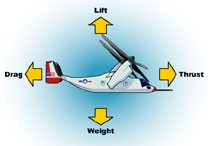Aerodynamics is the science that explains how air moves around objects and how objects move through the air. Understanding aerodynamics is key to knowing how airplanes fly, but it affects much more than just planes. From rockets launching into space to kites dancing in the wind, and even cars driving down the road, aerodynamics plays a role. Since we live surrounded by air, anything that moves is influenced by these principles.
The Four Forces of Flight Explained
To understand aerodynamics, it’s essential to learn about the four forces of flight: lift, weight, thrust, and drag. These forces dictate whether an object will move up or down, and how quickly or slowly it will travel through the air. The balance between these forces determines an object’s motion.
Image: Illustration depicting the four forces of flight – lift, weight, thrust, and drag – acting on an aircraft.
Understanding Weight: Gravity’s Pull
Weight is the force of gravity pulling down on an object. Gravity is what keeps us grounded on Earth, constantly pulling everything towards the center of the planet. The heavier something is (meaning it has more mass), the stronger gravity pulls on it, resulting in a greater weight. For anything to fly, it must overcome this downward force of weight. A lightweight kite needs less force to overcome weight compared to a massive jumbo jet, but both require lift to get airborne.
Understanding Lift: Defying Gravity
Lift is the force that pushes an object upwards, directly opposing weight. Anything that flies needs lift to counteract gravity. For an aircraft to ascend, the force of lift must be greater than the force of weight. A hot air balloon rises because the hot air inside is less dense, and therefore lighter, than the cooler air surrounding it – this difference in density creates lift. Helicopters generate lift using their rotating rotor blades, which push air downwards, creating an upward force. Airplanes, on the other hand, rely on the shape of their wings to generate lift.
How Airplane Wings Create Lift: The Magic of Air Pressure
The unique curved shape of an airplane wing, known as an airfoil, is crucial for creating lift. Airplane wings are designed to be curved on the top surface and relatively flat on the bottom. This shape forces the air flowing over the top of the wing to travel a longer distance than the air flowing underneath. Because the air on top has to travel further in the same amount of time, it speeds up. Faster-moving air exerts less pressure. This results in lower air pressure above the wing and higher air pressure below the wing. This pressure difference creates an upward force – lift – pushing the wing, and the airplane, upwards. This principle of using curves to manipulate air pressure isn’t limited to airplanes; helicopter blades, kite surfaces, and even sailboats utilize similar curved shapes to generate movement. A sailboat’s sail acts like a vertical wing, harnessing wind power to propel the boat forward.
Image: Diagram illustrating how an airfoil wing shape generates lift through differences in air pressure above and below the wing.
Understanding Drag: Air Resistance
Drag is the force that acts against motion, slowing things down as they move through the air. It’s a form of resistance. Think about walking through water compared to walking through air. Water creates much more drag, making it harder to move. The shape of an object significantly impacts the amount of drag it experiences. Streamlined, rounded shapes generally encounter less drag than blunt, flat shapes. Similarly, narrow objects tend to have less drag than wide ones because they push less air out of the way. The more surface area an object presents to the airflow, the greater the drag force will be.
Image: Illustration of a car moving through air, highlighting air as a drag force resisting its forward motion.
Understanding Thrust: Moving Forward
Thrust is the force that propels an object forward, overcoming drag. It’s the force that directly opposes drag. For any aircraft to maintain forward motion, thrust must be greater than drag. Small airplanes might use propellers to generate thrust, while larger jet airplanes rely on powerful jet engines. Gliders are unique because they don’t have thrust. They rely on initial momentum and gravity to fly, gradually slowing down due to drag until they eventually land.
Image: Cartoon of a jet airplane with a forward-pointing arrow to demonstrate the concept of thrust.
NASA’s Interest in Aerodynamics: Exploring Flight and Beyond
Aerodynamics is a fundamental area of study for NASA. In fact, the first “A” in NASA stands for Aeronautics, the science of flight. A core part of NASA’s mission is to advance aviation and make air travel safer and more efficient. Studying aerodynamics is essential to designing better airplanes and spacecraft. But aerodynamics is also crucial for other NASA missions beyond Earth. When probes land on planets like Mars, they must navigate through the planet’s atmosphere, even if it’s thin like Mars’. Understanding aerodynamics is therefore vital for successful space exploration and planetary landings.
Delve Deeper into Aerodynamics
- Dynamics of Flight: http://www.grc.nasa.gov/WWW/k-12/UEET/StudentSite/dynamicsofflight.html
- What Is Aerodynamics? (Grades K-4): https://www.nasa.gov/learning-resources/for-kids-and-students/what-is-aerodynamics-grades-k-4/
- Explore More for Students Grades 5-8: https://www.nasa.gov/learning-resources/for-students-grades-5-8/

